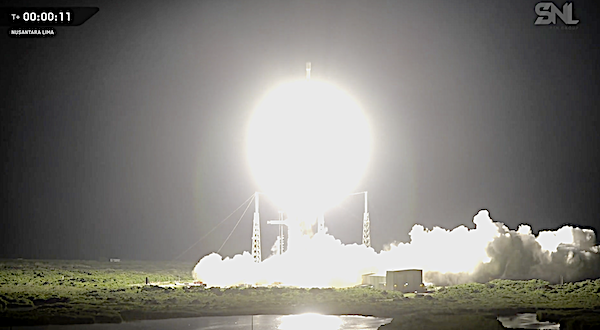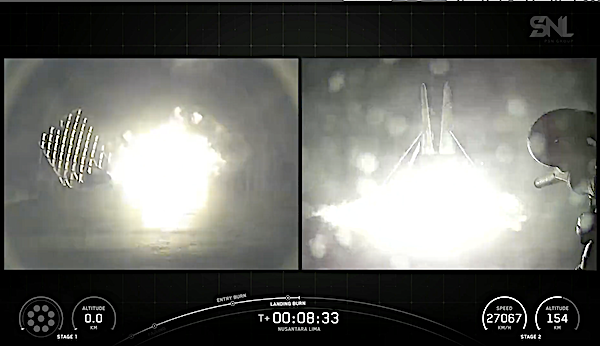
The weather at the Cape in Florida finally cooperated after three unsuccessful scrubs as SpaceX’s Falcon 9 on Thursday, September 11 launched the Nusantara Lima mission to geosynchronous transfer orbit from Space Launch Complex 40 (SLC-40) at Cape Canaveral Space Force Station in Florida. The launch took place 7:59 p.m. ET, with additional opportunities available until 9:56 p.m. ET. If needed, a backup opportunity is avail
The Nusantara Lima mission, led by Indonesia’s Pasifik Satelit Nusantara (PSN), involves launching a high-throughput telecommunications satellite to provide enhanced broadband services across Indonesia and surrounding regions. Built by Boeing on the 702MP satellite platform, Nusantara Lima will augment the capacity of the SATRIA-1 satellite, offering a total capacity of over 160 Gbps.
This satellite is designed to support underserved areas, providing reliable connectivity to remote regions, including rural hospitals and schools. Around 80 Gbps of its bandwidth will serve Indonesia, with additional capacity aimed at neighboring countries like Malaysia and the Philippines.
The satellite is part of Indonesia’s efforts to bridge the digital divide, providing internet access in areas where terrestrial communication infrastructure is not feasible. The mission will also rely on ground systems developed by partners such as Hughes Network Systems and Kratos Communications, ensuring operational efficiency and scalability.

This was the 23rd flight for the first stage booster supporting this mission, which previously supported Crew-6, SES O3b mPOWER-b, USSF-124, BlueBird 1-5, and 18 Starlink missions. Following stage separation, the first stage landed on the A Shortfall of Gravitas droneship, which is stationed in the Atlantic Ocean.
SpaceX’s three scrubs in a row, weather delay of Indonesia’s Nusantara Lima mission next on 9/11 from the Cape

SpaceX is targeting Thursday, September 11 for a Falcon 9 launch of the Nusantara Lima mission to geosynchronous transfer orbit from Space Launch Complex 40 (SLC-40) at Cape Canaveral Space Force Station in Florida. Liftoff is targeted for 7:59 p.m. ET, with additional opportunities available until 9:56 p.m. ET. If needed, a backup opportunity is available on Friday, September 12 during a 118-minute window that opens at 7:58 p.m. ET.
The Space Force’s 45th Weather Squadron only predicted 30% odds of favorable conditions early during the launch window, increasing slightly to 45% by the end. Cumulus clouds, anvil clouds and surface electric fields loomed as meteorological threats.
The Nusantara Lima mission, led by Indonesia’s Pasifik Satelit Nusantara (PSN), involves launching a high-throughput telecommunications satellite to provide enhanced broadband services across Indonesia and surrounding regions. Built by Boeing on the 702MP satellite platform, Nusantara Lima will augment the capacity of the SATRIA-1 satellite, offering a total capacity of over 160 Gbps.
This satellite is designed to support underserved areas, providing reliable connectivity to remote regions, including rural hospitals and schools. Around 80 Gbps of its bandwidth will serve Indonesia, with additional capacity aimed at neighboring countries like Malaysia and the Philippines.
The satellite is part of Indonesia’s efforts to bridge the digital divide, providing internet access in areas where terrestrial communication infrastructure is not feasible. The mission will also rely on ground systems developed by partners such as Hughes Network Systems and Kratos Communications, ensuring operational efficiency and scalability.
A live webcast of this mission will begin about 15 minutes prior to liftoff, which you can watch on X @SpaceX. You can also watch the webcast on the new X TV app.
This will be the 23rd flight for the first stage booster supporting this mission, which previously supported Crew-6, SES O3b mPOWER-b, USSF-124, BlueBird 1-5, and 18 Starlink missions. Following stage separation, the first stage will land on the A Shortfall of Gravitas droneship, which will be stationed in the Atlantic Ocean.
SpaceX scrubs Indonesia’s Nusantara Lima launch again as anvil clouds play havoc at the Cape for 2 days, perhaps Wednesday

Weather troubles again have caused SpaceX crews to scrub Tuesday’s launch with a hold at 29 seconds remaining from Space Launch Complex 40 (SLC-40) at Cape Canaveral Space Force Station in Florida. SpaceX will make a third straight attempt to launch the Boeing-built Nusantara Lima satellite on Wednesday night. This new launch window will open at 8 p.m., per SpaceX’s webcast commentator. Photo captured by Satnews.

According to weather officials, there’s a 30% chance of favorable weather conditions at the time of the launch. Officials are monitoring weather conditions with concerns related to Cumulus Cloud Rule, Anvil Cloud Rules, Surface Electric Fields Rule. The forecast calls for a temperature of 78°F, light rain, 20% cloud cover, a wind speed of 7mph and 0.42in of rain.
This will be the 23rd flight for the first stage booster supporting this mission, which previously supported Crew-6, SES O3b mPOWER-b, USSF-124, BlueBird 1-5, and 18 Starlink missions. Following stage separation, the first stage will land on the A Shortfall of Gravitas droneship, which will be stationed in the Atlantic Ocean.
SpaceX scrubs launch of Indonesia’s Nusantara Lima mission moves to Tuesday however Cape’s weather doesn’t look good again

SpaceX scrubs Monday’s launch and is now targeting Tuesday, September 9 for a Falcon 9 launch of the Nusantara Lima mission to geosynchronous transfer orbit from Space Launch Complex 40 (SLC-40) at Cape Canaveral Space Force Station in Florida. The116-minute window opens at 8:01 p.m. ET.
SpaceX stated that it is now targeting a 116-minute window that opens at 8:01 p.m. ET on Tuesday.
The company will send up its Falcon 9 rocket to launch the Boeing-built Nusantara Lima mission from Cape Canaveral Space Force Station’s Space Launch Complex 40.
The Falcon 9 will launch the Nusantara Lima communications satellite into geosynchronous transfer orbit for Pasifik Satelit Nusantara, Indonesia’s first satellite-based private telecommunications company.
However, the 45th Weather Squadron is predicting a poor launch forecast similar to Monday’s. The main concerns against the launch are: Cumulus cloud, anvil cloud, surface electric and fields rules.
According to weather officials, there’s a 30% chance of favorable weather conditions at the time of the launch. Officials are monitoring weather conditions with concerns related to Cumulus Cloud Rule, Anvil Cloud Rules, Surface Electric Fields Rule. The forecast calls for a temperature of 80°F, broken clouds, 80% cloud cover and a wind speed of 12mph.
A live webcast of this mission will begin about 15 minutes prior to liftoff, which you can watch on X @SpaceX. You can also watch the webcast on the new X TV app.
This will be the 23rd flight for the first stage booster supporting this mission, which previously supported Crew-6, SES O3b mPOWER-b, USSF-124, BlueBird 1-5, and 18 Starlink missions. Following stage separation, the first stage will land on the A Shortfall of Gravitas droneship, which will be stationed in the Atlantic Ocean.
SpaceX plans Monday launch from the Cape of Indonesia’s Nusantara Lima mission

SpaceX is targeting Monday, September 8 for a Falcon 9 launch of the Nusantara Lima mission to geosynchronous transfer orbit from Space Launch Complex 40 (SLC-40) at Cape Canaveral Space Force Station in Florida. The 116-minute launch window opens at 8:02 p.m. ET. If needed, a backup opportunity is available Tuesday, September 9 during a 116-minute window that opens at 8:01 p.m. ET.

The Falcon 9 will launch the Nusantara Lima communications satellite into geosynchronous transfer orbit for Pasifik Satelit Nusantara, Indonesia’s first satellite-based private telecommunications company.
A live webcast of this mission will begin about 15 minutes prior to liftoff, which you can watch on X @SpaceX. You can also watch the webcast on the new X TV app.
This will be the 23rd flight for the first stage booster supporting this mission, which previously supported Crew-6, SES O3b mPOWER-b, USSF-124, BlueBird 1-5, and 18 Starlink missions. Following stage separation, the first stage will land on the A Shortfall of Gravitas droneship, which will be stationed in the Atlantic Ocean.
